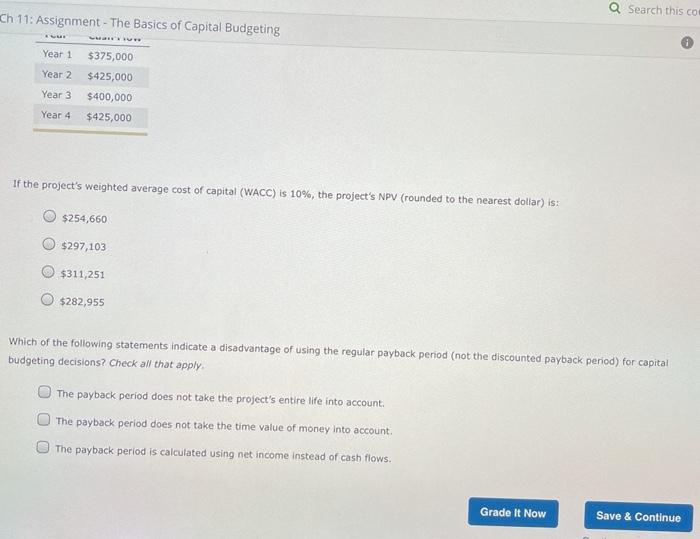Answered step by step
Verified Expert Solution
Question
1 Approved Answer
What information does the payback period provide ? Suppose you are evaluating a project with the expected future cash inflows shown in the following table
What information does the payback period provide ? Suppose you are evaluating a project with the expected future cash inflows shown in the following table . Your boss has asked you to calculate the project's net present value ( NPV ) . You don't know the project's initial cost , but you do know the project's regular , or conventional , payback period is 2.50 years . Year Cash Flow Year 1 $ 375,000 Year 2 $ 425,000 Year 3 $ 400,000 Year 4 $ 425,000 the project's weighted average cost of capital ( WACC ) is 10 % , the project's NPV ( rounded to the nearest dollar ) is : $ 254,660 $ 297,103 $ 311,251 $ 282,955 Which of the following statements indicate a disadvantage of using the regular payback period ( not the discounted payback period ) for capital budgeting decisions ? Check all that apply . 

Search this course Ch 11: Assignment - The Basics of Capital Budgeting 7. The NPV and payback period What information does the payback period provide? Suppose you are evaluating a project with the expected future cash inflows shown in the following table. Your boss has asked you to calculate the project's net present value (NPV). You don't know the project's initial cost, but you do know the project's regular, or conventional, payback period is 2.50 years Year Year 1 Year 2 Cash Flow $375,000 $425,000 $400,000 $425,000 Year 3 Year 4 If the project's weighted average cost of capital (WACC) is 10%, the project's NPV (rounded to the nearest dollar) is: $254,660 $297.103 $311,251 $282,955 Which of the following statements indicate a disadvantage of using the regular payback period (not the discounted payback period) for capital budgeting decisions? Check all that apply Q Search this col Ch 11: Assignment - The Basics of Capital Budgeting Year 1 Year 2 $375,000 $425,000 $400,000 $425,000 Year 3 Year 4 If the project's weighted average cost of capital (WACC) is 10%, the project's NPV (rounded to the nearest dollar) is: $254,660 $297,103 $311,251 $282,955 Which of the following statements indicate a disadvantage of using the regular payback period (not the discounted payback period) for capital budgeting decisions? Check all that apply. The payback period does not take the project's entire life into account. The payback period does not take the time value of money into account The payback period is calculated using net income instead of cash flows. Grade It Now Save & Continue 

Step by Step Solution
There are 3 Steps involved in it
Step: 1

Get Instant Access to Expert-Tailored Solutions
See step-by-step solutions with expert insights and AI powered tools for academic success
Step: 2

Step: 3

Ace Your Homework with AI
Get the answers you need in no time with our AI-driven, step-by-step assistance
Get Started


